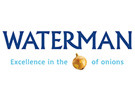The end of September sees Waterman Onions’, in the Netherlands, main seed onion harvest done and dusted. Owner, Erik Waterman, says yields vary enormously. “They sometimes differ by as much as 20 to 30%. The mostly lighter soil plots got off to a good, and things look good. But the heavy soil areas already face a tougher start.

“And they had a dry spring and heat in June. That didn’t help. Many of those plots have very irregular crop distribution. Fortunately, the situation on many lots has improved. But there are still vast regional differences. We’ll have to wait and see how things turn out, in terms of both yield and quality.”
Erik reckons market conditions are quite good. “In this period, you usually have to deal with some pressure from competing onion sets. But that’s not the main issue anymore. So far, sales have been fairly stable. Two years ago, the dry weather caused onion demand to sky-rocket. That’s not the case now. This year, there’s more of a ‘normal’ harvest expectation. If we can keep prices competitive, I think our chances on the world market will be favorable. With a sorted onion price of about €0.20, we can be globally competitive. And remain so.”

The Waterman Onions owner sees that the demand for organic onions keeps growing. But acreage has increased accordingly. “Across Europe, organic onions have had some problems with diseases. Yields and quality will, therefore, vary greatly from region to region. Here in the Netherlands, the greatest opportunities with organic onions will present themselves in the spring,” Erik expects.
This year, red onions’ outlook on the world market is reasonably positive. “However, in Europe, sales of red onions to the foodservice and hospitality sectors have dropped sharply. Last year was a unique situation. India and its neighboring countries presented themselves as red onion clients. That was certainly unusual. Current red onion prices are fairly stable.”

The packer believes the onion sector is generally weathering the corona crisis well for now. “When it comes to sales, each country has its issues. That could be in the area of payment transactions. But some countries often channel their sales through open (wholesale) markets. So, there, sales are often lower than usual. The benefit of onions, however, is that if they’re not sold one way, they’ll get sold in another. In this case, via different sales channels.”
“In terms of total consumption, we haven’t, in any case, noticed any major adverse effects. Like salt and pepper, onions are a true, indispensable commodity. You find onions in every kitchen worldwide. It’s, therefore, not a luxury, but a necessary vegetable. It’s no wonder then that onions along with tomatoes are the most popular and most important vegetables in the world.”

When it comes to innovation, sustainability is a hot topic at Waterman. “In the area of packaging, for example, we’re trying to find something that’s manufacturing isn’t based on fossil fuels. We haven’t found it yet, but that’s our goal. For us, sustainability isn’t just a buzz word. It’s becoming an increasingly integral part of our entire company. At our Dutch locations, we already generate all the power we need, almost entirely sustainably. Our fleet is already almost entirely electric too. And last but not least, we’re working hard on residue-free onion cultivation.”
“This doesn’t necessarily have to be organic. Sustainable, conventional, and eco-friendly cultivation is slowly merging. Does this earn you more? Not always or well enough - that could change. Certainly when you see all the sometimes extraordinary efforts and costs. These are made to create added value for the whole chain’s partners. But as chain partners, you need to organize this transparently. And it really has to mean something. Having GlobalGAP-certified onions used to give you an advantage. But that has become more and more standard nowadays.”

Convenience is another significant development on the onion field. “Our generation and the previous one still kept a large bag of onions in the cellar. Now, we pack onions in pairs or separately for certain clients. The younger generation’s menu is increasingly determined by HelloFresh or a particular app. Convenience is key. One time they need a shallot, the next a yellow, red, pink, or white onion. We also have the advantage that onions are used in many different ways in various cuisines.”
Erik considers dealing with weather conditions as an important challenge for the sector. “It was extremely dry and hot two years ago. But, everyone quickly dismissed as ‘only happening every 20 years’. Now it’s the third dry summer in a row with considerably less rain. This makes the availability of freshwater and sufficient irrigation a must. Here in (the province of) Flevoland, we may have enough water available.”

“But if we can’t buffer enough throughout the Netherlands, we also have a problem. I do realize, however, that Flevoland is the Valhalla of onion farming. Not only with the polders. There are also emerging cultivation areas in nearby Dutch provinces. So, we’re in a great central location. We, therefore, focus primarily on Dutch onions. But, as a back-up, we always need onions from other countries. These include Tasmania, New Zealand, and Egypt.”
“In short, there are plenty of challenges for onions. Our company certainly wants to face them enthusiastically and with ambition,” concludes Erik.
Erik Waterman
|erik@waterman-onions.nl
Voor meer informatie: Waterman Onions
Waterman Onions
Hannie Schaftweg 12
8304 AR Emmeloord
+31 (0)527 617 496
info@waterman-onions.nl
www.waterman-onions.nl
